[Retracted] The Application of Computer-Based Virtual Technology in Volleyball Training
Abstract
At present, science and technology have become an important step in the reform and development of sports, promoting the vigorous development of sports in our country. From the perspective of virtual computer technology, this paper applies virtual computer technology to modern training and designs a training system for volleyball players based on virtual reality technology. First, collect the sports data of the athletes, use the virtual reality perception interaction model to input the data into the virtual environment generation unit, perform data fusion under the control of the simulation management module, and combine the database in the sports simulation volleyball training data unit and the sports in the image card Behavioral interpretation, simulating 3D modeling based on User settings within the 3D Model Processor. The test results show that the system helps to improve the training effect of athletes, saves the cost of sports training, and has high practical application value.
1. Introduction
As one of the three major balls, volleyball is deeply loved by the masses, but the number of people who really participate in volleyball in schools or in society is relatively small compared to football and basketball, and this largely affects the further development of volleyball [1]. As an important place for training volleyball professionals, sports schools are important in the training and training of volleyball reserve talents, how to improve the quality of volleyball training in sports schools, enrich the reserve talents of volleyball, and ensure that my country’s volleyball sports achieve great results in the world volleyball competition is an important task in front of [2]. Through CNKI’s research on volleyball training and other keywords, it is found that most of the research on volleyball training is at the school level, and few scholars have studied volleyball in sports schools. Moreover, the research content is relatively simple. We study the current situation, existing problems, and development paths of volleyball training and explore ways and methods for improving volleyball training [3].
The growth of volleyball reserve talents needs to go through a series of processes such as discovery, selection, training, and transportation. The training of my country’s volleyball reserve talents mainly relies on the platform of sports schools. In recent years, as more and more problems have been exposed by sports schools, for example, sports schools pay too much attention to sports performance and neglect the study of cultural courses. To a large extent, these cases have caused many parents to be reluctant to send their children to sports schools for study and training, resulting in a decline in the number of students enrolled in sports schools, which affects the sports performance of sports schools in the later period [4].
For a long time, in the process of volleyball training in our country, the teacher’s explanation and demonstration and students’ practice are used most frequently in physical education and training in my country and have existed for the longest time. Even to a large extent, this form of sports training mode has become the norm in physical education and training [5]. This mode of teaching has inhibited the development of sports to a large extent. The traditional teaching mode has inhibited sports in three aspects: First, if students train in this mode for a long time, their interest in learning is greatly reduced; second, teachers have adopted the same teaching method for many years, and the teaching method is outdated, which is difficult to stimulate teachers’ passion for teaching and training, and affects the quality of training; the third is the pursuit of short-term results in the pursuit of quick success and instant benefits, which greatly affects the step-by-step exercise training, resulting in insufficient basic skills of athletes, and easy to encounter bottlenecks in the later development [6].
Computer virtual technology establishes an interactive relationship with people by simulating various images, postures, and actions in real time. In sports, computer virtual technology provides standardized guidance and correction opinions for athletes’ sports training by simulating the movement process of athletes. In addition, when using computer virtual technology, athletes must create diversified sports scripts to meet their needs for different sports in modern sports training and improve the benefits of sports training is still an urgent problem. Therefore, the study of computer virtual technology applied in modern sports training has certain practical significance.
The current physical education still has backward teaching mode, unreasonable structure of teaching staff, lack of field equipment, low management level, insufficient theoretical teaching hours, and so on, which do not meet the current needs of my country’s higher education to cultivate comprehensive and compound talents. Through the research on VR, this paper analyzes the characteristics of VR in different directions and believes that the application of VR technology can promote the significant change of people’s attitude towards sports, accelerate the significant change of sports content, improve educational methods, optimize educational environment, and improve the educational evaluation system [7]. On this basis, the application of virtual reality in college volleyball training will help to improve the efficiency of volleyball training and popularize volleyball. For example, crosscountry running and taekwondo, etc., physical training in virtual scenes can avoid all kinds of accidental injuries and attract athletes to actively participate in sports training with the interesting training atmosphere of the machine. Of course, under the computer virtual technology, if the athlete has incorrect training postures and movements, he will be well guided in the virtual scene, as well as his standard and standardized movements for sports training [8–10].
With the help of computer virtual technology, through computer technology to simulate the sound, essence, and taste of the real world, we can naturally communicate and interact with athletes in the virtual environment. Of course, under the impact of computer technology, virtual technology can give athletes some experience, overcome the limitations of the traditional computer interface, and enhance the virtual sports training experience. The application of computer virtual technology in modern sports training can provide early guidance for athletes’ sports training and reduce the possibility of accidental injury in sports.
2. Related Work
Competitive sports based on standard technical movements require participating athletes to have skilled technical movements. To achieve this goal, it is not only necessary for athletes to continue to train hard but more importantly, to provide coaches with scientific and effective training methods to improve volleyball training [11]. The technical level of my country’s competitive sports volleyball training has always been relatively low. Most coaches teach volleyball training through experience and subjective awareness and only rely on experience and visual judgment to guide athletes’ technical movements, resulting in athletes’ needing several times. The technical essentials can only be mastered by repeated practice, which results in the low quality of training in my country’s competitive sports volleyball and the slow improvement in the level of technical movements. Researchers have concluded through research and actual verification that adding digital graphics and image technology to volleyball training can improve the efficiency of athletes’ grasp of technical essentials during volleyball training and effectively reduce the probability of injury during volleyball training and improve the overall volleyball training effect [12].
Athletes’ simulated volleyball training process is the main content of athletes’ daily training [13]. The currently commonly used athlete simulation volleyball training systems are roughly divided into traditional training systems based on artificial neural networks [14] and training systems based on mechanical exercise devices [15]. Both of these two simulated volleyball training systems have different problems such as long time to master the training content, poor training effect, and high cost. As a high-tech product in the field of modern Internet technology, VR technology provides people with a virtual experience environment by establishing a virtual world [16]. Based on this, the application of VR technology to athletes’ simulated volleyball training has become the future development trend of athletes’ simulated volleyball training systems [17]; therefore, an athlete simulation volleyball training system based on VR technology is designed to diversify the athlete’s virtual training.
The main features of VR are as follows: (1) immersion: the images in the virtual environment will change with the movement of the user’s head, and they can also hear three-dimensional simulation sounds, making the human body feel better. It will feel immersive and get the same effect as in the real scene [18]; (2) multisensitivity: in addition to the vision of general computer technology, it also has a variety of perceptions such as auditory, tactile, and kinesthetic; so, users can obtain more and more in the virtual environment. This kind of perception then achieves the approximate real feeling [19, 20].
The application of VR technology in volleyball training falls in many aspects. Sometimes, in volleyball training for students, the teacher’s explanation and demonstration cannot grasp the real focus; so, the training will be more effective, not in vain [21–24].
Therefore, we study the simulation system of volleyball sports training based on VR technology to improve the training of volleyball. By way of motion capture data acquisition initial motion forms database, an offset correction and design movement in the database movement mapping technology, according to the athlete body parameters, combined with the human body motion formula, examine the rationality of the action after modifying design, standard techniques, motion stitching way choreography to simulate each standard techniques. After obtaining a whole new set of standard technologies to simulate the movements, it is compared and analyzed with athletes’ training movements videos in the same screen synchronization mode, so as to improve the quality and training level of volleyball movements and realize the simulation of volleyball training [25].
3. Athlete Simulation Volleyball Training System Using VR Technology
3.1. Framework of the System
The athlete simulated volleyball training system based on VR technology is composed of three parts: input unit of sports simulated volleyball training, generation unit of virtual environment, and output unit of sports simulated volleyball training. The specific structure is in Figure 1. The input unit of sports simulation volleyball training includes position and direction sensor module, conversion module, data glove module, and glove input control module, which is mainly responsible for collecting athletes’ sports data. Virtual environment generation unit is composed of simulation management module, user application module, 3D model processing module, and computer, which is responsible for building and managing virtual environment. It is the core unit of the athlete simulated volleyball training system based on VR technology. The sports simulation volleyball training output unit is mainly composed of effect generator and signal converter, which is responsible for realizing virtual training effect and communicating with users.
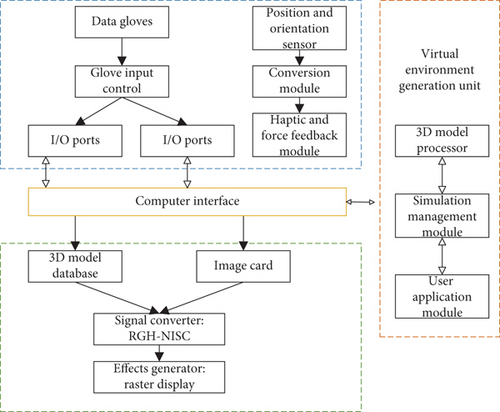
3.2. VR Perception Interaction Model
This VR system can simulate the scene in the process of training athletes and record motion simulation input unit input training sports movement and the related data, through the sports movement and the related data analysis, to identify whether movements of athletes’ training process set standards and at the same time can also be in the process of training for athletes that do not reach the standard of action to prompt, to improve the training quality of athletes. Therefore, the virtual training system of athletes should be combined with VR technology to meet the data input and output functions and at the same time to ensure the maximum simulation of athletes’ training movements based on VR technology, so as to instantly feel the most real and reliable virtual environment of sports training. Figure 2 shows the VR perception interaction model in the virtual environment generation unit simulation management module.
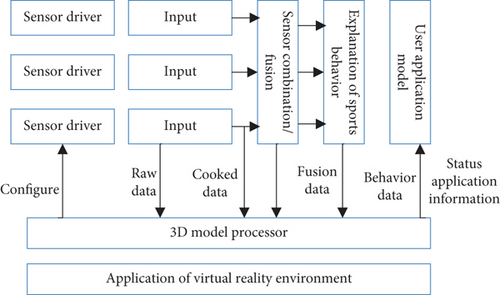
Virtual environment within the unit, the simulation management module based on the three-dimensional model of the processor, the motion simulation of each sensor in the volleyball training input unit drive acquisition athletes in sports training simulated raw data fusion, combined with exercise behavior explanation, according to user’s setting in a three-dimensional model to simulate the processor within the 3D modeling, will eventually application status information shown on the display.
3.3. 3D Reconstruction of Virtual Athletes and Construction of Movement Standard Action Library
Choose 3D Studio MAX Built-in scripting language MAXScript design volleyball athletes’ simulation training system of virtual 3D reconstruction software athletes, guide trained athletes, and track athletes’ training parts with real-time attitude for the purpose, in the process of volleyball athletes’ simulation training and control standard virtual athlete real-time display training action, at the same time in the user application module, using the virtual athletes which show the movement track of the trained movement of the athlete participating in the training. The athletes who participate in sports training are trained in real time under the guidance of the standard actions of virtual human, and the system uses dialog box mode to feedback the virtual training effect to the athletes. Figure 3 shows the software running process of the virtual training system for athletes.
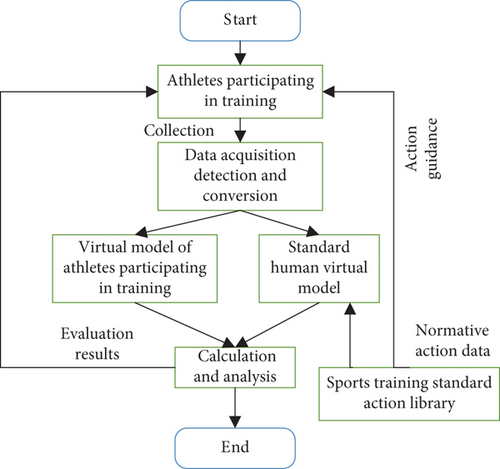
In order to help athletes and related coaches to call corresponding sports training standard movements to implement training according to different athletes’ training conditions, the virtual human movement standard movement library should be gradually constructed in the process of constructing the athletes’ simulated volleyball training system based on VR technology. Its structure is mainly composed of two parts: ① athletes’ training records including the name, age, gender, movement, and effect evaluation of athletes participating in sports training and ② including movement number, type, position and angle, and other sports training standard movements.
3.3.1. Volleyball Training Movement Correction and Design
Motion capture is an ideal way to create 3D database of volleyball movement training. Its basic principle is to use sensor tracking equipment to complete the volleyball sports training target movement data record. Its characteristic is that it can successfully capture the actual movement data of human body and the movement information collected has time information, which can improve the simulation fidelity of the change of human movement state. The movement data of marked points on human body surface were recorded by optical principle, and the record was taken as the initial 3D movement data. In order to extract 3D human motion skeleton from such data successfully, filtering and noise reduction are necessary.
By selecting original frames to create a system that can match the virtual identifiers of the motion capture target and the skeleton, and based on the minimum spacing between the actual identifiers and the virtual identifiers, the bone motion of the motion capture data is optimized. The motion data obtained from the optimized operation were denoised by smoothing processing method, and the smooth bone motion was obtained after filtering by the quaternion linear time-invariant filtering system. Euler angle data is converted into corresponding quaternions by logarithmic operation and mapped to tangent space. Filter is used to filter the tangent space. The filtered results are mapped to quaternions by exponential operation and converted into Euler angle data. Database has been created by completing volleyball training reality and synthesizes each action with VR software package VHSDK5.0, and through the 3D form, at the same time, the visualization method of reality and the rectification movement and interaction design, through the Newton Euler motion model for correction and design finished by a reasonable degree of inspection, to acquire new action. Get the standard technique of volleyball training with individuation.
Based on the characteristics of athletes’ body parameters, the inertia parameters of human body were estimated, and the required rotational inertia parameters in the Newton-Euler motion model were established to achieve personalization. According to the equation, the reasonable degree of the new movement′(t) was tested, and the interactive process of visual interaction design, motion testing, and feedback was realized. The aim of correcting and designing volleyball movement training is achieved.
3.3.2. Volleyball Training Movement Choreography Simulation
where . Based on this, the spatial curve qi(t) connected with can be obtained by curve splice. After the exponential change of the spatial curve, it is mapped to the unit quaternion space to obtain the four countless curves gi(t) connected with . Thus, the new standard action sequence can be obtained after the volleyball training action fragments n1(t), n2(t) are connected n(t). Compare and analyze the sequences with athlete training videos on the same screen, so as to improve the training guidance level of coaches and athlete action technical standards.
3.4. Simulation Application of VR Technology
where W represents the actual value of the vector, and a, b represent the results of consistency test and root method analysis, respectively. Based on VR technology, the application performance of the athlete simulated volleyball training system can be optimized, and the effect of athlete simulated volleyball training can be improved based on a series of simulation identification and weight division methods.
4. Experiments
To verify the practical application effect of the athlete simulated volleyball training system designed in this paper based on VR technology, an athlete training hall was selected as the research object, and 120 athletes participating in different sports training projects were selected to conduct simulated volleyball training using the system in this paper. The results are as follows.
4.1. Data Acquisition Test
In this paper, position and direction sensors are used to collect movement data of athletes, as shown in Figure 4. The system action data acquisition errors are in Table 1. From Table 1, the movement error of athletes collected by the system in this paper is basically controlled within 0°20′, which indicates that the system in this paper can collect athletes’ sports training data more accurately, which is conducive to the improvement of the sports training effect of the system in this paper.
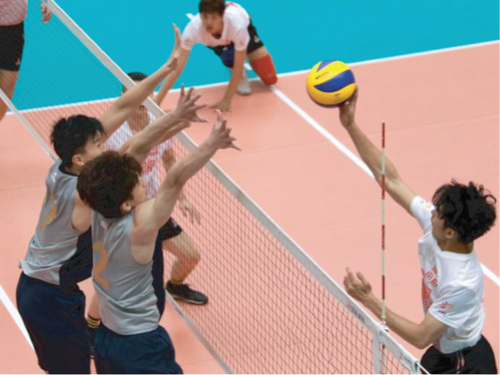
| Athlete number | Left arm up | Lumbar curvature | ||
|---|---|---|---|---|
| Athlete action | System display action | Athlete action | System display action | |
| 13 | 33°58′ | 55°39′ | 57°41′ | 69°12′ |
| 20 | 56°30′ | 32°63′ | 62°33′ | 22°39′ |
| 35 | 52°47′ | 19°22′ | 22°29′ | 45°78′ |
| 67 | 37°19′ | 48°11′ | 36°45′ | 29°48′ |
| 98 | 71°35′ | 82°69′ | 37°50′ | 22°59′ |
| 115 | 51°47′ | 49°51′ | 26°65′ | 52°37′ |
Through the PC/Windows/VC5.9 software environment to realize the system development, application of the system simulation so-and-so man volleyball players serve technique, and the y direction of Euler angle, respectively, two actions contrast technique of simulation results with the y direction of Euler angle similarity and test paper system simulation results. Technical action effect presentation and Euler angle representation are shown in Figure 5. It is seen that the simulation effect of the system on the two technical actions is very consistent with the Euler angle representation in the y direction, indicating that the simulation effect of the system in this paper is good, the simulation results can be used in the actual volleyball training, and it is easier to modify the actions based on the simulation results of the system. In addition, the simulation results can be used for comparative analysis with training videos.
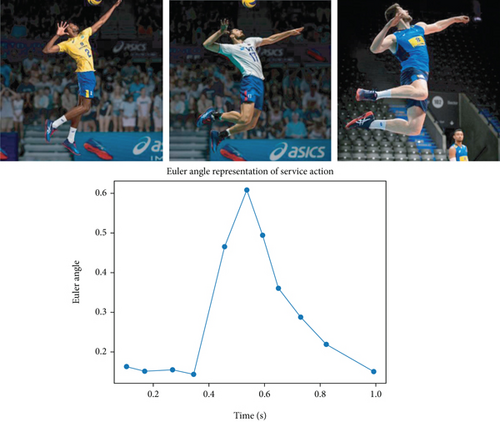
4.2. Comparison of Training Effects
During the comparison of athletes’ training effects, the mastery of training content is selected as the comparison index. In the selected 120 athletes, 15 athletes of similar age and basically the same physical quality were selected and randomly divided. The first group adopted the traditional training system based on artificial neural network in literature [2] for sports training, the second group adopted the training system based on mechanical motion devices in literature [3] for sports training, and the third group adopted the system described in this paper for sports training. Athletes in the three groups were trained with different sports training systems for eight weeks, and the training effects of athletes are shown in Figure 6. According to Figure 6, athletes (group 3) trained by the system in this paper had a significantly better grasp of training content after the first week of training than those trained by the other two systems (group 1 and group 2), with a grasp of training content as high as 73.86%. With the extension of training time, the athletes of each group have improved their mastery of training content. After training, the mastery of the training content of the athletes using this system reached about 95%, while the mastery of the training content of the athletes using the other two systems was lower than 80%. The system in this paper performs better on athlete training and is more suitable for athlete training.
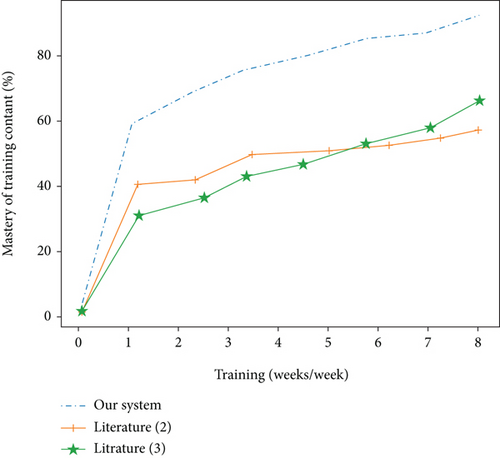
10 athletes were selected from the two teams to test the volleyball training effect before and after the application of the system in the paper. By comparing the athletes’ mastery of technical movements and mastery efficiency, the volleyball training effect was compared, see Figure 7 for the comparison of volleyball training results. You can see from Figure 7, after the application of the system, two team volleyball training grasps of the technical movements. Numbers are higher than before application of the system and each control technique, to master the movements used long before the application of the system is reduced; therefore, two teams after the application of the system of volleyball training are more effective and more efficient.
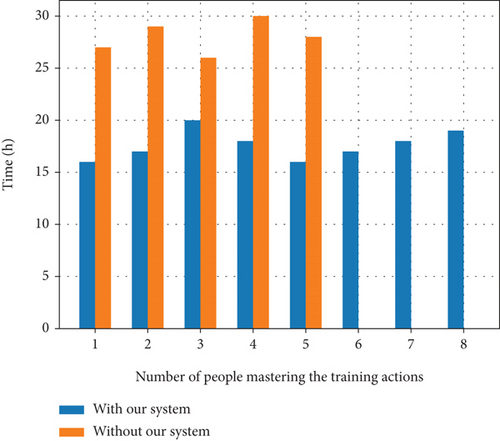
The actual application effect of the system can be further verified by the average time taken by the two teams to master each technical action before and after the application of the system in the paper. The comparison results are in Table 2, the two teams in volleyball training after application of the system; on the master of technique degree is higher, the average motion control efficiency is also improved significantly, and the application of the system after the two teams’ technical movement control proportion were 70% and 80%, respectively, is far higher than 40% before application of the system and 50% proportion, enough to illustrate; the system in this paper has very high practical application value and remarkable application effect.
| Comparison name | Comparative data | After applying the system in the text | Before applying the system in the text |
|---|---|---|---|
| Serve action | Master the number of moves | 8 | 5 |
| Serve action | Average time to master the movement/h | 18.3 | 27.9 |
4.3. Cost Comparison
In the experiment of comparing the training effect, the cost of each group of athletes in the eight-week training process is shown in Table 3. According to Table 3, in the first week of training, the cost of the system in this paper was reduced by 0.5000 yuan and 0.3000 yuan, respectively, compared with the other two systems. With the extension of sports training time, the cost of training using the system in this paper has been consistent with the cost of training in the first week; that is, after the eight-week training, the cost of sports training using the system in this paper is always 80,000 yuan. However, the cost of training using literature [2] system and literature [3] system increased at the speed of 20,000 yuan and 11,000 yuan per week, respectively; that is, after the eight-week training, the cost of sports training using the other two systems reached 27,000 yuan and 88,000 yuan, respectively. This shows that the cost of sports training using this system is lower, more in line with the actual application.
5. Conclusion
The research of volleyball training assisted by VR technology will have a far-reaching influence on improving the technical level of volleyball players, improving the teaching environment of volleyball training, and optimizing the teaching process of volleyball training at and cultivating talents with innovative ability. In the current volleyball training, most schools still use the more traditional training methods, a few schools use multimedia volleyball training, and VR technology is almost no. Despite the high cost of VR technology, it has not been popularized in universities, but with the continuous development and improvement of VR technology, as well as the reduction of the cost of hardware equipment, VR technology as a new multimedia teaching means, with its own advantages and potential, will gradually be paid attention to and favored. Finally, it is widely used in the field of volleyball training and plays an important role.
Conflicts of Interest
The authors declared that they have no conflicts of interest regarding this work.
Open Research
Data Availability
The experimental data used to support the findings of this study are available from the corresponding author upon request.




